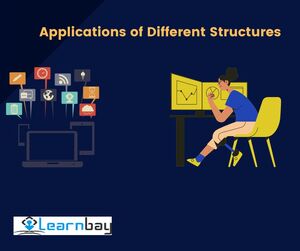Applications of Different Structures
Body
We have described the practical uses for different data structures, ranging from the widely used Array and Linked List to the geometric R-Tree and probabilistic LogLog.
Data structures
Midway through the 20th century, computer science began to take off. As it grew, so did the requirement to organise and store data in a form that made it simpler to access and manage. Then, due to scientists' efforts to modify mathematical notions of data organisation for computer use, the discipline of data structures was born.
Data structures were initially developed as relatively straightforward structures like arrays and linked lists, but as computers became more powerful, new algorithms, and techniques emerged, and the field of data structures expanded to include a wide range of more sophisticated structures like trees, graphs, and other advanced structures. Click here to know more about the instructor-led DSA course, designed comprehensively for working professionals and beginners.
Non-linear and linear data structures are the two categories under which data structures fall.
Data is organised linearly in these types of data structures. Additional divisions include:
Static data structures are those that are linear and have a fixed size. eg: Array
Data structures with a variable size are said to be dynamic data structures. During operation, it may receive random updates. e.g., vectors;
The non-linear data structure Data will not be organised linearly in these data structures. example: Trees, Graphs, etc.
Arrays
In the past, programmers had to utilise many variables to store related data, which made the code harder to develop, read, and maintain. Additionally, this made it more challenging to sort or search for data using mathematical processes.
In other words, arrays are data structures that hold a group of elements of any data type in a continuous memory area.
The following fundamental operations can be performed on elements in an array: accessing an element, traversing the array, searching for an element, adding or deleting an element, sorting, reversing the array, etc.
Applications of arrays in the real world
- Database indexing: To make data retrieval quick and easy, databases' data are first organised using arrays.
- In image processing, arrays are used to represent images, with each element corresponding to a pixel's colour. Arrays can be used to construct image processing methods including filtering, scaling, and compression.
- In game programming, arrays are used to store information like characters' ratings, the locations of objects in a game's universe, and other things.
- Sorting and searching: Data that has to be sorted or searched is stored in arrays.
- Spreadsheets: To store data and execute computations on it, spreadsheet programmes like Microsoft Excel and Google Sheets employ arrays.
Matrix
The necessity for matrices evolved from the need to effectively store and handle massive amounts of data with a two-dimensional structure.
A matrix is a two-dimensional collection of elements, most frequently composed of numbers or expressions. The row and column indices of a matrix's cells serve as placeholders for each matrix cell, and this notation is used to access any of those cells. Two-dimensional tables, arrays, and grids are other names for matrices.
The various matrix operations include addition, subtraction, scalar multiplication, multiplication of matrices, transposition, determinant, inverse, trace, multiplication of eigenvalues, and multiplication of eigenvectors.
Applications of matrix in real life
- In many scientific disciplines, including engineering, physics, computer graphics, etc., systems of linear equations are used. Matrices are used to represent and manage these systems.
- Matrices are used in computer graphics to represent and control geometric changes including translation, rotation, and scaling.
- Data representation and manipulation are utilised in machine learning methods like neural networks and Principal Component Analysis (PCA), among others.
- Robotics: In the kinematics and dynamics of robotics, matrices are utilised to depict and control the movements of robotic systems.
- In encryption and decryption methods like the RSA and the Hill cypher, matrices are utilised to represent and modify data.
Stack
When elements needed to be added and deleted in a certain order, with the most recently added element being removed first, there was no effective way to store and handle elements in that order. Thus, the requirement for stacking arose.
A detailed explanation can be found in a data structure course, available online.
The Last In First Out (LIFO) principle is used to stacks, which are linear data structures. The "top" of the stack, also known as the same end, is where pieces are added and deleted. It is claimed that an element is "pushed" into the stack when it is added, and that an element is "popped" off of the stack when it is removed.
Several real-world uses include:
- Computer science: Stacks are used in programming languages to control function calls and create algorithms like depth-first search.
- Web browsers: In order to allow users to move through a history of web pages, stacks are utilised to implement the back and advance buttons in web browsers.
- In text editors, graphics editors, and all other software, the undo and redo feature is implemented via stacks in the graphical user interface.
- Calculator and math software: Stacks are used to evaluate expressions such as arithmetic and programming language expressions.
- Computer networks: They are used to manage data packet flow and to put routing algorithms into practise.
Queue
When storing and manipulating data, there was a time when the oldest piece had to be the first to be eliminated. The necessity for the queue data structure developed in this manner. An element is added to the rear of a queue and withdrawn from the front of a queue in a queue, which is a linear data structure that adheres to the First In First Out (FIFO) principle. The frequently used operations are enqueue, dequeue, peek, isEmpty, size, and clear.
Here are some examples of real-world uses:
- Operating systems: Queues are used to control the scheduling of processes, and each process is assigned a priority number before being placed in a queue.
- Queues are used in computer networks to control how packets move through the system, for example, by buffering incoming data before sending it.
- They are employed in the simulation of line-ups in real life.
- Transportation: The management and optimisation of the flow of people and products is accomplished by using queues.
- Games: In video games, queues are used to control player actions and movement.
Binary Tree
For this reason, binary trees were created. Hierarchical data, where each item has a parent-child connection with other objects, needed to be efficiently stored and manipulated. It is a node-based data structure, where each node has a maximum of two child nodes.
Insertion, deletion, searching, traversal, and other operations are examples of common operations.
Here are some examples of real-world uses:
- File Systems: File systems such as NTFS and ext3 use a binary tree to arrange and index files.
- Creating a game: Games like chess and checkers require a binary tree to describe the game state and carry out game-tree searches.
- Making decisions: The binary tree is a representational tool used by some decision-making algorithms, such as the ID3 algorithm.
- Data compression: Huffman coding uses a binary tree to represent the frequency of characters in a data set. It is a lossless data compression method.
- In natural language processing, binary trees are frequently used to represent the structure of sentences in sentence parsing, sentence analysis, syntactic and semantic analysis, and machine translation.
Binary Search Tree
The desire to effectively store and search for data in a fashion that allows for quick search times gave rise to the need for binary search trees.
A sort of binary tree called a binary search tree (BST) is created specifically to store and retrieve data quickly. A BST's primary benefit is its capacity for quick searches. Because of the way the tree is set up, all of the values in a node's left subtree are lower than its value, and all of its right subtree values are higher.
Insertion, deletion, searching, traversal, tree cloning, serialisation and deserialization are a few examples of common operations.
If you want to get detailed information, do check out the online data structures and algorithms course, offered by Learnbay.
A few examples of real-world uses are:
- Spelling checker: They employ BST to look up words rapidly in a dictionary and check for misspellings.
- File Systems: A lot of file systems, like NTFS and ext3, organise and index files using a binary search tree.
- Computer Network Routing: Routing methods use binary search trees to identify the quickest path for data to flow through a network. One such approach is the Spanning Tree Protocol.
- Evaluation of mathematical expressions: Some compilers and interpreters store and evaluate expressions using BST.
- Machine translation, syntactic and semantic analysis, phrase parsing, and other aspects of natural language processing (NLP) frequently use binary search trees to represent sentence structure.









Comments